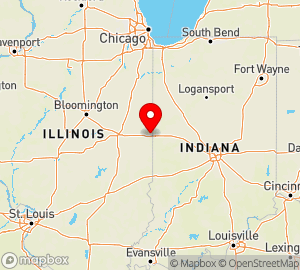Illinois
Illinois State Information

www.illinois.gov
Area (sq mi):: 57914.38 (land 55583.58; water 2330.79) Population per square mile: 229.60
Population 2005: 12,763,371 State rank: 0 Population change: 2000-20005 2.80%; 1990-2000 8.60% Population 2000: 12,419,293 (White 67.80%; Black or African American 15.10%; Hispanic or Latino 12.30%; Asian 3.40%; Other 7.90%). Foreign born: 12.30%. Median age: 34.70
Income 2000: per capita $23,104; median household $46,590; Population below poverty level: 10.70% Personal per capita income (2000-2003): $32,185-$32,965
Unemployment (2004): 6.20% Unemployment change (from 2000): 1.70% Median travel time to work: 28.00 minutes Working outside county of residence: 25.20%
List of Illinois counties:
Illinois Parks
- US National Parks
- Urban Parks
- State Parks
- Parks and Conservation-Related Organizations - US
- National Wildlife Refuges
- National Scenic Byways
- National Heritage Areas
- National Grasslands
- National Forests
Illinois
Twenty-first state; admitted on December 3, 1818
The 150th, or sesquicentennial, anniversary of Illinois’ statehood was celebrated throughout the state during 1968. In December 1967, a year-long exhibit on Illinois history opened at Chicago’s Field Museum of Natural History. Miniature replicas of historic rooms—Carl Sandburg’s birthplace, Jane Addams’s Hull House office, and the Palmer House Hotel’s Silver Dollar Barber Shop of 1875—were on display in Carson Pirie Scott department stores. Lincoln’s birthday on February 12 was observed with programs commemorating his career in Illinois. On July 4, there was a parade, drama, musical events, fireworks, and speeches at Steeleville. As part of the year-long celebration, the Old State House in Springfield was restored.
State capital: Springfield
Nicknames: Prairie State; Land of Lincoln; Corn State
State motto: State Sovereignty, National Union
State animal: White-tailed deer (Odocoileus virginianus)
State amphibian: Eastern tiger salamander
State bird: Cardinal (Cardinalis cardinalis)
State dance: Square dance
State fish: Bluegill (Lepomis macrochirus)
State flower: Violet (Viola)
State fossil: Tully Monster (Tullimonstrum gregarium)
State insect: Monarch butterfly (Danaus plexippus)
State mineral: Fluorite
State prairie grass: Big bluestem (Andropogon furcatus)
State reptile: Painted turtle
State song: “Illinois”
State tree: White oak (Quercus alba)
More about state symbols at:
www.illinois.gov/facts/symbolsdesc.cfm
www.state.il.us/kids/learn/symbols/default.htm
More about the state at:
www.illinois.gov/facts/history.cfm
SOURCES:
AmerBkDays-2000, p. 809 AnnivHol-2000, p. 201
STATE OFFICES:
State web site: www.illinois.gov
Office of the Governor State Capitol Bldg Rm 207 Springfield, IL 62706 217-782-6830 fax: 217-782-1853 www.illinois.gov/gov
Secretary of State State Capitol Bldg Rm 213 Springfield, IL 62756 217-782-2201 fax: 217-785-0358 www.sos.state.il.us
Illinois State Library 300 S 2nd St Springfield, IL 62701 217-782-2994 fax: 217-785-4326 www.cyberdriveillinois.com/departments/library/home.html
Legal Holidays:
Illinois
a state in the northern United States. It is located in the northern part of the Central Plain, between Lake Michigan, the Ohio River, and the Mississippi River. Area, 146,000 sq km. Population, 11.1 million (1970; 83 percent is urban). Capital, Springfield. The most important city and chief economic center is Chicago; more than 60 percent of the state’s population lives in Chicago and its suburbs.
Illinois is located on major transcontinental routes and the most important internal waterways of the United States. The topography is a rolling plain (with heights up to 378 m in the north), covered with rich black soil. The climate is temperate and continental. During the coldest month the mean temperature is— 3°C, and during the warmest month, 25°C. The annual precipitation ranges from 800 to 1,000 mm. Illinois is rich in coal, petroleum, fluorspar, and other minerals.
Illinois is a highly developed industrial and agricultural state, ranking fifth in the United States in industrial and agricultural production and in population. Of the economically active population, 32 percent are employed in manufacturing, 0.5 percent in mining, and 4 percent in agriculture. In 1968, the state’s mineral output included 56 million tons of coal and 10.6 million tons of petroleum. Of the 1.4 million workers employed in the manufacturing industry (1969; 980,000 in Chicago), nearly 50 percent are employed in the machine-building and metal-working industries, almost 10 percent in metallurgy, and 10 percent in the food industry. The leading branches of industry include radioelec-tronics; locomotive and railroad-car building (Chicago, Rock-ford, Rock Island, and Peoria); ferrous metallurgy (primarily in Chicago); petroleum-refining; chemicals; meat packing (Chicago and East St. Louis); and the production of electrical, industrial, and construction equipment, as well as of agricultural implements. The printing, garment, and distilling industries are well developed.
Illinois is part of the Corn Belt, the most important agricultural region in the United States. Eighty-five percent of the land is under cultivation. The principal crops are corn (second in production in the USA) and soybeans (first in production); wheat, oats, and forage are also grown. Livestock-raising constitutes more than 50 percent of agricultural production. As of January 1970 livestock in Illinois included 3.3 million cattle, 6.6 million hogs, and 389,000 sheep. There are 18,000 km of railroad lines and 170,000 km of highways in Illinois. The Illinois Waterway, a canal route connecting the Great Lakes system with the Mississippi River Basin, passes through the state.
V. M. GOKHMAN
Illinois
a river in the United States, left tributary of the Mississippi River. It is formed by the junction of the Des Plaines and Kankakee rivers. Length, 437 km (from its source at the Kankakee, 653 km); basin area, 82,000 sq km. The riverbed has a number of enlargements resembling lakes. It is fed by rain and snow. There are high waters between March and May. The water is at its lowest level during the summer and fall. The average annual discharge is approximately 1,000 cu m per sec. In its upper course the Illinois is linked by navigable canals with Lake Michigan (at Chicago) and with the Mississippi River. The river has locks and is navigable along its entire course. Above the city of La Salle, it is paralleled by a canal. The city of Peoria is located on the Illinois River. [10-374 -2]